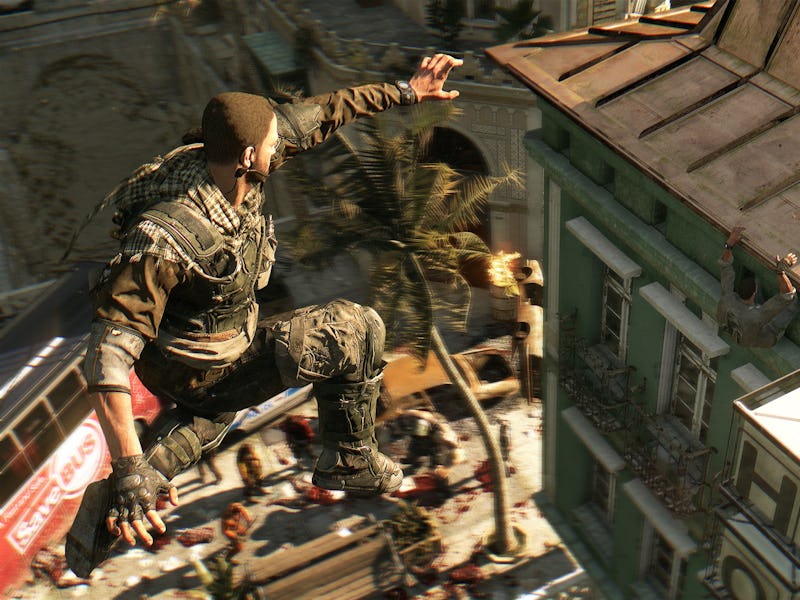10 Years Ago, The Ultimate Zombie Game Gave Players A Million Reasons To Return
A must-play classic.

A little over a decade ago, the world was up to its neck in zombie content. The success of the multimedia hit The Walking Dead made the zombie apocalypse appointment television. Valve’s co-op hit Left 4 Dead was an established gaming mainstay with an active online community six years after its release. Even Call of Duty had an entire mode dedicated to the classic horror monsters.
So when developer Techland announced its new zombie game Dying Light in 2013, it was hard to understand how this was supposed to stand out from the pack. Techland released Dead Island two years prior, a memorable first-person zombie game about crafting cool weapons and surviving on a picturesque destination getaway. On its face, Dying Light seemed like a retread, with a slapped-on parkour gimmick to spruce things up.
How very wrong those assumptions were. Despite a similar premise, Dying Light was very much its own thing. And some ten years later, its legacy stands as one of the best zombie games ever thanks to its memorable mechanics, atmosphere, and years of unmatched post-launch support.
In Dying Light, you play Kyle Crane, a humanitarian organization operative dropped into the fictional Middle Eastern city of Harran amid a viral outbreak. Within the chaos, you’re tasked with tracking down a rogue national leader thought to be responsible for the outbreak. Throughout its 18-hour campaign, players balance completing the mission and helping survivors stuck in the quarantined city. You can even invite up to three friends for co-op shenanigans.
As the premise suggests, Crane isn’t just a run-of-the-mill average Joe. He’s a very capable lawman who knows how to dispatch foes. His abilities and athleticism are further bolstered when he learns the basics of parkour from the locals early on in the game. Players quickly learn here that acrobatics are a fundamental part of this game’s brand of survival.
Techland’s appreciation for DICE’s cult-classic Mirror’s Edge is clear. Scaling walls, shimmying across ledges, and jumping between buildings are all there. But added mechanics like vaulting off the chests of zombies to reach higher places and the versatile grappling hook advance Mirror’s Edge’s ideas in smart, novel ways. And while in the day parkour can feel like a fun twist on platforming, at night it's used exquisitely to fill the player with tension.
When the sun goes down in the open world of Harran, the very core of the game changes. You’re no longer running across town to complete objectives dispatching the undead as you see fit. Instead, you’re avoiding enemies the best you can, with limited visibility and few ways to defend yourself. When you are inevitably detected, being chased by predators who are just as nimble as you is a sense of horror that few games have accomplished since 2015. The sensation of fleeing for your life while chaining together leaps of faith with zero room for error is terrifying and exhilarating all at once.
“The sensation of fleeing for your life while chaining together leaps of faith with zero room for error is terrifying and exhilarating all at once.”
How the game combines its movement mechanics with the punchy-first person combat built on Dead Island’s produced one of the best zombie games of the decade. But Techland wasn’t satisfied with that accolade. Instead, it built on that foundation for years. As a result, Dying Light remains one of the best examples of how post-launch support can make a great game excellent.
Within three months of its January 2015 release, Techland released developer tools, letting the mod community flourish. In five months, it released three DLC packs worth of missions, new weapons, and modes that let you become a zombie and fight waves of progressively more difficult zombie hordes. A year after release, Techland dropped an entire expansion called The Following, which added a new story campaign, abilities, and a drivable, upgradable vehicle.
The Following would be as good a place as ever to wind down support, but Techland kept going. Over the next four years, it added new weapons, crossover events, and items from games like Chivalry: Medieval Warfare and Left 4 Dead 2. In 2020, a new mode that lets less skilled players enjoy the game’s story with less of a challenge was added. Even after the game’s 2022 sequel was released, Techland would drop a free next-gen upgrade for the original and add a new community even as recently as 2024.
The Following’s dune buggy adds an entirely new dimension to the exploration and missions.
For nine years, Techland gave Dying Light fans a reason to return to its best game. Cyberpunk 2077 and Baldur’s Gate 3 are the few games that can compare when it comes to post-launch support. Both are fantastic games to be in the company of.
For a game that started development as a spiritual close follow-up to Dead Island, it's remarkable how much of a worthwhile departure Dying Light became. Its fun game design is timeless. And the developer’s careful curation of new content and support constantly reminded players just how great this gem is. Dying Light’s twist on an overdone genre truly stands the test of time a decade later.